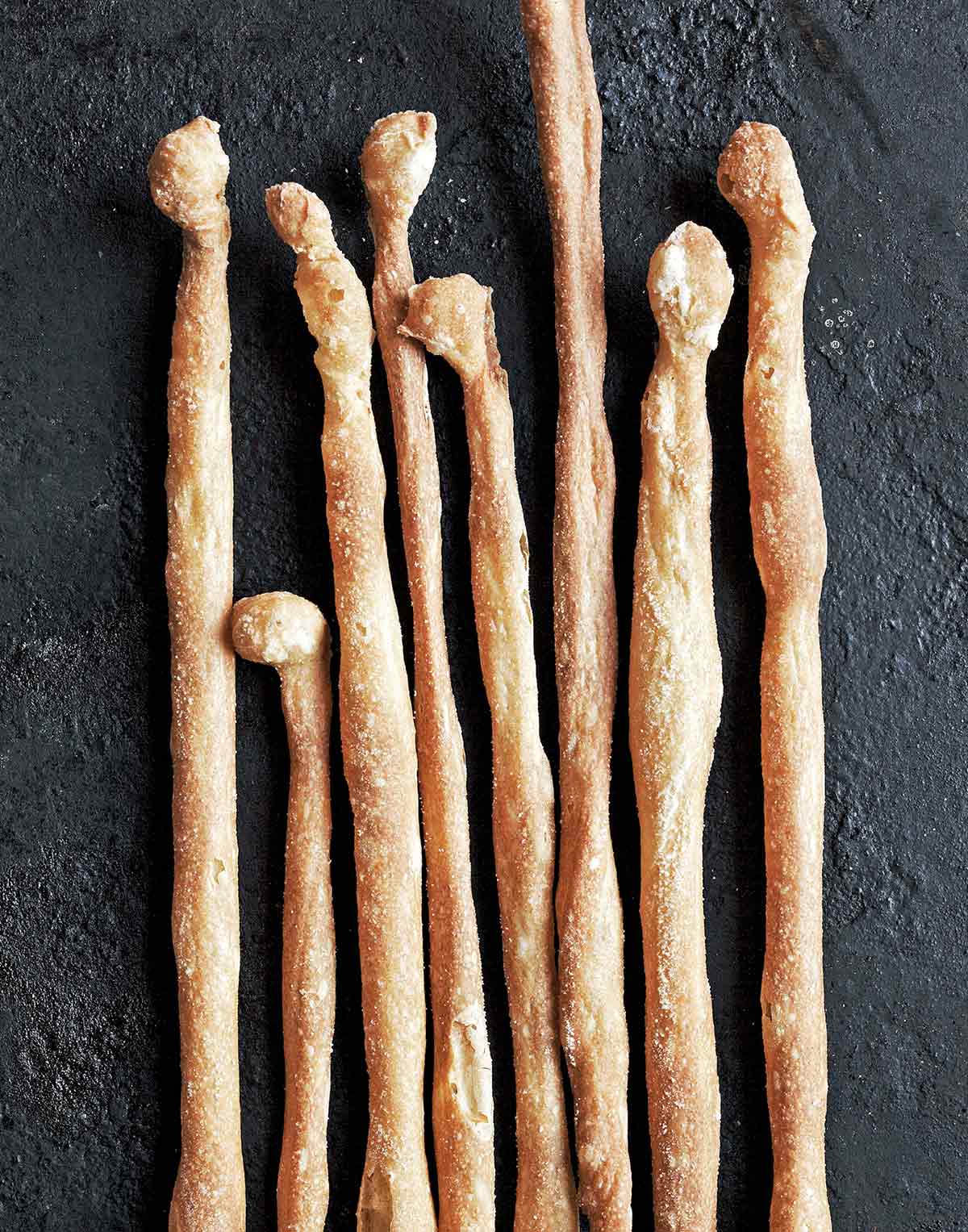
TL;DR (Quick-Answer Box)
- What it is: An authentic recipe for Grissini Torinesi, or Italian breadsticks, made with a simple dough of flour, water, yeast, olive oil, and salt, resulting in a thin, crisp, and satisfyingly addictive snack.
- Why you’ll love it: Ditch the stale restaurant breadsticks; this version is outrageously crispy, easy to prepare, and tastes incredible as an appetizer alongside dips, cheese, or wine.
- How to make it: Mix and knead the dough, let rise for about an hour until doubled. Pat the dough into a 14-by-4-inch rectangle, then cut into strips, stretch strips to a baking sheet’s length, and bake until golden and crunchy.

Jump To
Most Americans know grissini as those pale breadsticks in the long waxen envelopes that appear on the tables of Italian restaurants, but those bear about as much resemblance to authentic grissini, or Italian breadsticks, as packaged industrial white bread does to true country loaves.
Real grissini are made of yeast, flour, water, and either olive oil, lard, or butter. They are shaped between the hands by gently stretching the dough to about the span of the baker’s arms, and are then baked directly on the floor of a wood-burning oven. They are as thick and irregular as knobby fingers and look like cordwood when stacked. They have crunch and an earthy taste. Even when made at home with the methods and recipe that follow, they are still redolent of the countryside and the old ways.–Carol Field
Technically speaking, the proper name of these skinny, crunchy, yeasty, moan-inducingly lovely light sabers of bready goodness is grissini Torinesi. Confession: We’ve been referring to them simply as grissini, a word that rolls off the tongue in a way that “Torinesi” does not. Anyone who’s up for the challenge of a little advanced Italian can, of course, pronounce its full name over and over and over again, to his or her heart’s content, along with grissini Siciliani and grissini al papavera, two classic variations on this Italian breadstuff staple. You’ll find the how-tos for these variations beneath the breadsticks recipe that follows.
How Do I Serve Grissini?
Serve grissini with eggs, green salad, prosciutto, and smoked beef, as well as with any kind of antipasti. Some Italians eat them for breakfast with milk or coffee, a tradition that was once widespread.
More Crunchy Snacks Recipes
Cheese Crackers
25 mins
Cheddar-Parmesan Crackers
2 hrs 40 mins
Stilton and Walnut Crackers
1 hr 10 mins
Peppery Cheese Straws
35 mins
Want to save this?
Write a Review
If you make this recipe, or any dish on LC, consider leaving a review, a star rating, and your best photo in the comments below. I love hearing from you.–David
Featured Review
Those grissini are just amazing! Easy to prepare and super tasty. They go great with a glass of wine and some spreads or cheeses and are my go-to treat for short-notice visits from friends. Everybody without exception who’s tried it has loved them. I use crushed dried rosemarin, za’atar, and paprika, or add only cumin seeds. Either way, those sticks are just great!
Eliza
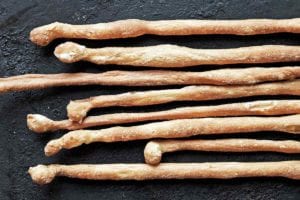
Italian Breadsticks ~ Grissini Torinesi
Equipment
- Baking stone (optional)
Ingredients
- 1 3/4 teaspoons active dry yeast
- 1 tablespoon malt syrup, (you can substitute molasses, honey, or sugar, although the malt syrup gives the crust a nice color)
- 1 1/4 cups warm water, (or 1/4 cup warm water plus 1 cup cold water if using a food processor)
- 2 tablespoons extra-virgin olive oil, plus more for brushing and for the pans
- 3 3/4 cups unbleached all-purpose flour, plus more for the work surface
- 1 1/2 teaspoons salt
- 1/2 cup cornmeal or coarse semolina flour, plus more for dusting the baking stone (optional)
Instructions
- Make the dough by hand: Stir the yeast and malt into the warm water in a large mixing bowl; let stand until foamy, about 10 minutes. Stir in the oil. Add the all-purpose flour and salt and stir until the dough comes together. Knead on a lightly floured surface until smooth, soft, velvety, and elastic, 8 to 10 minutes.Make the dough with a stand mixer: Stir the yeast and malt into the warm water in a mixer bowl; let stand until foamy, about 10 minutes. Mix in the oil with the paddle. Add the all-purpose flour and salt and mix until the dough comes together. Change to the dough hook and knead at low speed about 3 minutes. Finish kneading briefly by hand on a lightly floured surface.Make the dough with a food processor: Stir the yeast and malt into the 1/4 cup warm water in a small bowl; let stand until foamy, about 10 minutes. Place the all-purpose flour and salt in a standard food processor fitted with the dough blade or a large (over 7-cup capacity) processor fitted with the steel blade and process with several pulses to sift. Mix the 1 cup cold water and the oil in a small bowl. With the machine running, pour the water mixed with oil and the dissolved yeast through the feed tube and process until the dough comes together. Process 45 seconds longer to knead. Finish kneading briefly by hand on a lightly floured surface.
- Pat the dough with your hand into a 14-by-4-inch rectangle on a well-floured surface. Lightly brush the top with oil. Cover loosely with plastic wrap and let rise until doubled, about 1 hour.
- Preheat the oven to 450ºF (232ºC). If you are using a baking stone (for crunchy breadsticks), turn the oven on 30 minutes before baking. Lightly oil 2 baking sheets.
- Sprinkle the dough with the cornmeal or semolina flour before cutting and stretching. The traditional method of shaping breadsticks is ingenious, simple, and quick, and doesn’t make you roll out individual grissini. Cut the dough crosswise into 4 equal sections and then cut each section crosswise again into 5 strips, each about the width of a fat finger. The dough is so elastic that you can simply pick up each piece, hold each end with your fingers, and pull and stretch to fit the length of a baking sheet. Place the breadsticks several inches apart on the baking sheets. There is no need to let them rise.
☞ TESTER TIP: We find it easier to use the backs of the baking sheets, unless you have rimless sheets.
- Bake the breadsticks for 20 minutes. If you like crunchy breadsticks, transfer the breadsticks directly to the baking stone for the last 5 minutes of the baking time, but only after sprinkling the stone with cornmeal or coarse semolina. Let the breadsticks cool on racks.
Notes
Italian Breadstick Variations
Grissini Siciliani Sprinkle the dough with 1/2 cup sesame seeds instead of cornmeal or semolina flour before cutting and shaping the breadsticks. Grissini al papavera Sprinkle the dough with 1/2 cup poppy seeds instead of cornmeal or semolina flour before cutting and shaping the breadsticks.
Explore More with AI
Nutrition
Nutrition information is automatically calculated, so should only be used as an approximation.
Recipe Testers’ Reviews
This grissini recipe produced crunchy, authentic Italian grissini. I followed the recipe as written but did note some differences in the final product based on how the breadsticks were formed. I placed half on the sheet pan the short way and the other half on a different pan the long way. Those that were shorter and fatter had a much doughier consistency than the crunchier, longer batch made according to the recipe’s directions. The crunchier batch seemed more authentic to me. The semolina left a floury residue on the exterior, which I didn’t love. Next time I’ll cut down on the semolina by as much as half.
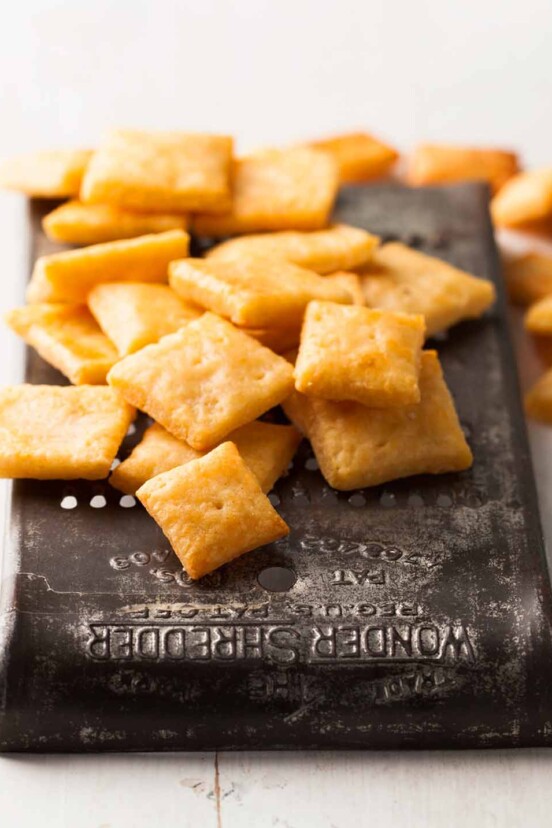

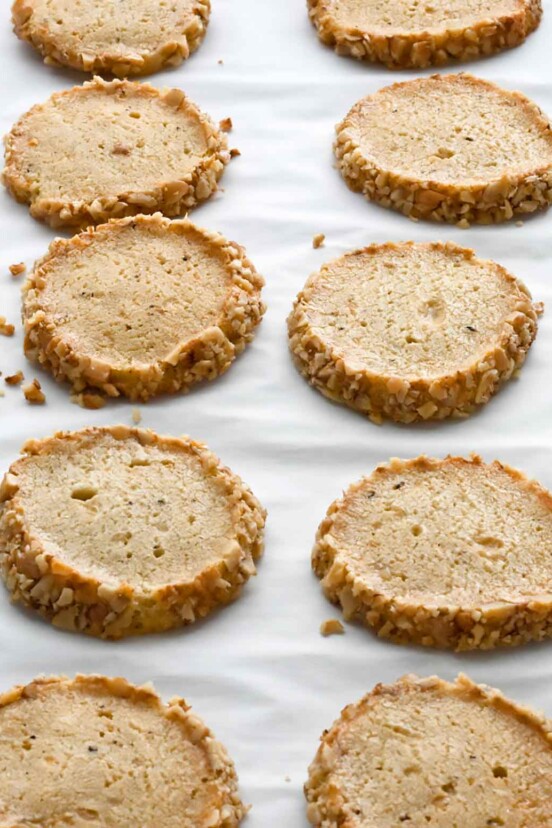
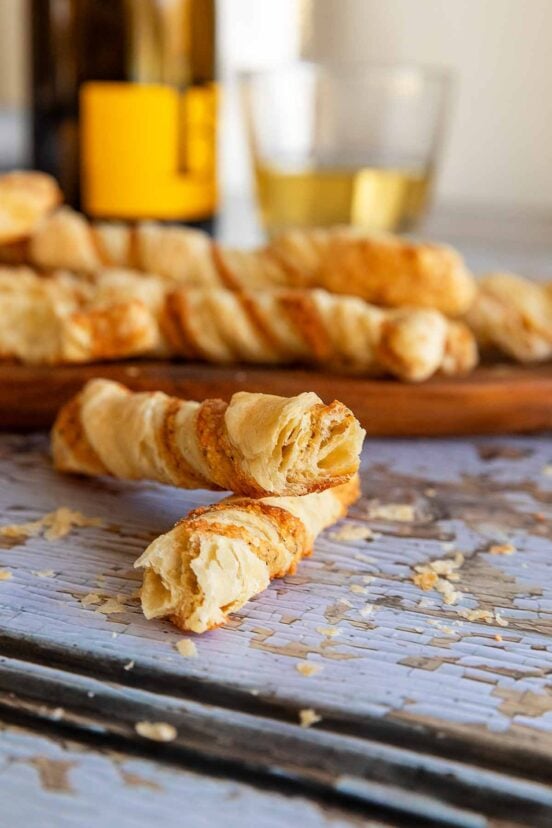










Those grissini are just amazing! Easy to prepare and super tasty. They go great with a glass of wine and some spreads or cheeses and are my go-to treat for short-notice visits from friends. Everybody without exception who’s tried it has loved them. I go for the food processor method and it works perfectly with the simplest kind of white flour. I started experimenting with mixing herbs in and the results have been great. I use crushed dried rosemarin, za’atar, and paprika, or add only cumin seeds. Either way, those sticks are just great!
Eliza, I’m delighted you enjoyed these grissini. They are wonderful, and your additions sound great. Perhaps others will follow you into the world of breadsticks and make them, too!
Which way crosswise? Short or long way first? And the second time? Need photos. Need help picturing.
Jennifer, you’d first cut the 14-x-4-inch piece of dough across the short way, so you’d end up with four 3 1/2-x-4-inch squares. Then cut the squares into five strips, it doesn’t matter which way on this step. Then stretch those strips.